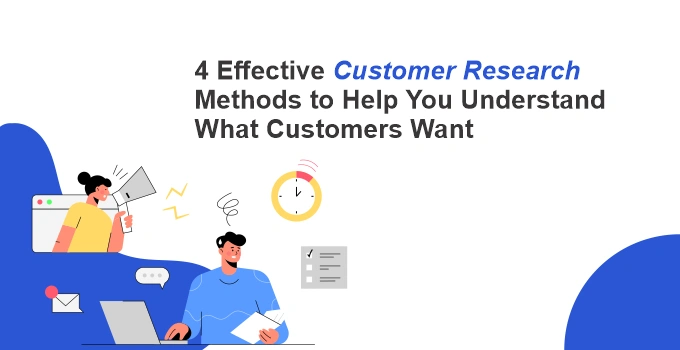4 Customer Research Methods to Understand Customers Needs
Do you ever feel like you’re guessing when making product and process improvements? How can we try to see what customers want? To avoid costly mistakes, we must constantly conduct customer research to identify our customers’ needs and expectations.
Understanding customer behavior and what they want is key to building a successful business and keeping customers happy and returning for more. Customer research methods can be difficult and time-consuming to do but there are four methods that you can use which will help you learn more about your customers and their needs which will in turn help influence what will sell in your stores. Let’s check out the 4 most effective customer research methods.
1. Questionnaires and Surveys
Questionnaires and surveys are among the most popular methods of customer research. This is because they are easy to set up, cost little or nothing, and can be conducted on a wide scale. Furthermore, like with every study technique, there are drawbacks as well as benefits. The most frequent techniques used mostly by advertisers to discover what potential consumers think are questionnaires and surveys. They are so widely used that it’s easy to forget how misleading they can be.
A survey is a set of questions. Asking questions is easy. But getting answers worth having is hard. Survey results are always misleading in at least three ways:
- They omit information that is important but unanticipated by the researcher.
- They include information that is unimportant but anticipated by the researcher.
- They include information that is important and anticipated by the researcher but reported by respondents in ways the researcher doesn’t understand.
When conducting surveys it is important not only to ask the right questions but also to make sure the answers are accurate and representative of the general public’s opinion on the topic.
A questionnaire consists of two parts:
- The questions
- The instructions
The questions must make sense to the respondent; the instructions must help the respondent answer the questions correctly. When designing a questionnaire, its layout is important too. A good layout eases the completion of the questionnaire by providing space between questions and short lines on which people can write their answers easily.
The length of a questionnaire depends on several factors including:
- How complex are the questions? Questions that assess complex concepts require more space for explanation than do simpler questions
- How many options are there? More options require more space for explanations.
- How much information is already available about these issues
Click here to read: Improve Your Customer Experience in 6 Steps
2. Analyze Social Media Data and Information
Marketing tactics have grown more reliant on social media. Because of its inherent advantages, it is one of the most important marketing channels that help to spread the word about your business most quickly. Any marketing effort would be incomplete without it. Social media can be considered one of the most effective customer research methods because it helps you understand what customers want.
By analyzing social media data and information, you can locate problems, identify market trends, find solutions for customer complaints, discover new potential markets, and find ways to enhance your customers’ experience with your business, and so on.
Researching on social media sites like Twitter, Facebook, Google, LinkedIn, etc., allows you to tap into the conversations that your audience is already having. This allows you to provide instant feedback on their needs as well as receive real-time insight as to what they would like from your brand or company.
3. Acquire Both Good and Negative Comments from Customers
There are a variety of successful consumer research techniques that may assist you in determining what your customers’ desire. One of the most effective customer research methods is to acquire both good and negative comments from customers while also observing what they do while using your product or service. This can assist you to figure out what’s wrong with your product or service and how to fix it.
One of the reasons why obtaining both good and negative comments from customers is an effective customer research method is because negative comments tell you how to make improvements to your product or service while positive comments tell you how well you’ve been doing up until now.
Another reason why this is a good customer research method is that acquiring both good and negative comments from customers gives you a wide range of information about your product or service that will allow you to turn it into a more successful one.
Another reason why this is a good customer research method is that it provides prospects with a “Reality Check” that will help them get a clearer picture of what they’re buying into. The last thing that anyone wants is to buy a product or service that doesn’t meet their expectations, so by providing prospects with warnings beforehand, they have time to change their minds if they don’t want to go through with the transaction.
Click here to read: 3 Best Online Advertising Channels to Grow Your Small Business
4. Take Heed on Secondary Research
Secondary research is anything that you gather from sources other than the customers themselves. This could be talking with industry experts, analyzing previously gathered primary data, or reviewing the results of primary research conducted by others. It’s often used as a way to get background information so you can frame your primary research more effectively.
Secondary research is most valuable when it helps you to understand why customers behave the way they do. Knowing the underlying reasons for the behavior gives you a better understanding of how to reach them with your product or service offering.
For example, if you were launching a line of men’s wear targeted at young urban professionals, secondary research might show that this group values casual living and individuality in their clothing choices, but cares more about quality and durability than price. This insight can help refine your message to them, steer you away from developing products that don’t address their concerns and give you ideas about how to position your product about others on the market.
Secondary research may be found in a variety of places, including:
- Reports from reputable research organizations
- According to news reports
- Journals of higher education
- Newsletters
- Newspapers and magazines
Researching Your Customers Will Give You Valuable Information for Managing Your Business
Your customers are a huge asset. Business people tend to think that customer research is something you do when you don’t know what you’re doing. That’s why it’s called market research. It’s like an admission that you don’t know who your customers are or what they want. But if your company is any good at all, you don’t need to conduct market research to learn what your customers want. You already know.
As every business leader knows, the key challenge in running a business isn’t making smart decisions; it’s making decisions fast. The faster you can make and correct decisions, the better off you’ll be. And the best way to make and correct decisions is to eliminate as much uncertainty as possible and replace it with knowledge. That means knowing what your customers need and want before they tell you — and then giving it to them before they ask for it.



